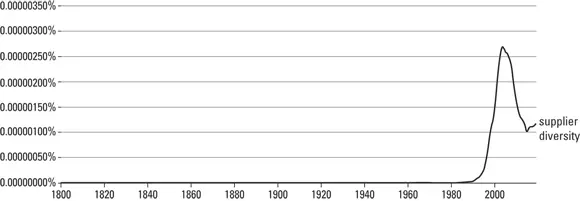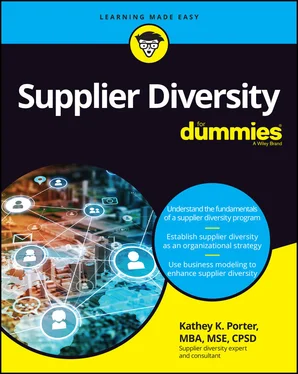Kathey K. Porter - Supplier Diversity For Dummies
Здесь есть возможность читать онлайн «Kathey K. Porter - Supplier Diversity For Dummies» — ознакомительный отрывок электронной книги совершенно бесплатно, а после прочтения отрывка купить полную версию. В некоторых случаях можно слушать аудио, скачать через торрент в формате fb2 и присутствует краткое содержание. Жанр: unrecognised, на английском языке. Описание произведения, (предисловие) а так же отзывы посетителей доступны на портале библиотеки ЛибКат.
- Название:Supplier Diversity For Dummies
- Автор:
- Жанр:
- Год:неизвестен
- ISBN:нет данных
- Рейтинг книги:4 / 5. Голосов: 1
-
Избранное:Добавить в избранное
- Отзывы:
-
Ваша оценка:
- 80
- 1
- 2
- 3
- 4
- 5
Supplier Diversity For Dummies: краткое содержание, описание и аннотация
Предлагаем к чтению аннотацию, описание, краткое содержание или предисловие (зависит от того, что написал сам автор книги «Supplier Diversity For Dummies»). Если вы не нашли необходимую информацию о книге — напишите в комментариях, мы постараемся отыскать её.
Supplier Diversity For Dummies,
Supplier Diversity For Dummies
Supplier Diversity For Dummies — читать онлайн ознакомительный отрывок
Ниже представлен текст книги, разбитый по страницам. Система сохранения места последней прочитанной страницы, позволяет с удобством читать онлайн бесплатно книгу «Supplier Diversity For Dummies», без необходимости каждый раз заново искать на чём Вы остановились. Поставьте закладку, и сможете в любой момент перейти на страницу, на которой закончили чтение.
Интервал:
Закладка:
When organizations or individuals think their livelihood may be in jeopardy, they change their behavior. This concept is a relatively new one that many organizations are embracing. According to supplier.io, many of the Top 50 Companies for Diversity (as recognized by DiversityInc magazine) are placing more emphasis on achieving diversity/supplier diversity goals and tying executive compensation to the effort. This move not only provides additional incentive to hit supplier diversity goals but also reinforces the importance of diversity as a core value in the company.
Considering what supplier diversity needs to do to stay relevant
If supplier diversity is to continue to evolve, maintain its relevancy, and usher in a new era of supplier diversity, some pointed actions need to occur:
Continued investment in current and pipeline professionals: As supplier diversity evolves, so must the professional profile of its leaders. Organizations have to have a clear understanding of the function when drafting job descriptions and hiring (as I note earlier in the chapter, this position isn’t a catchall). Today, certification and training programs offer professionals an opportunity to build their skills in this area to ensure that they’re prepared to hit the ground running and not necessarily learning on the job. I discuss building a career in supplier diversity in Part 6.
Development of industry standards: People have long complained that the industry can be fragmented because of different standards and requirements across industries. For a long time, supplier diversity took its cues from the federal government. But as corporate supplier diversity grew, those programs began establishing their own standards, which sometimes creates confusion for the small and diverse businesses (and even industry professionals). It has also created a bit of a chasm between professionals that work in public supplier diversity and private (corporate) supplier diversity. The industry has to work together to create standards that help uplift the entire industry, an act that would likely go a long way in crafting a message that makes gaining buy-in at the organizational level easier.
Proactive mindset shifts from senior leadership: Like anything, priorities shift. New leaders have different ideas for where the organization should focus its energies. As much as you may want everyone to be proactive and progressive, they just aren’t. This area is one of the reasons supplier diversity is a continual process that requires constant work on culture and change management. So much so that everyone, even a leader, will have to get with the program, or they may find themselves a poor culture fit.
A strategic focus with key performance indicators (KPIs) that align with big-picture goals: Supplier diversity has to shift its narrative to one focused on strategy. Some organizations still likely treat this initiative as a charity or philanthropic effort rather than a true strategic management function. Supplier diversity has to develop those KPIs that align with the organizational goals to demonstrate the value that it brings in achieving them.
Reputation management: Supplier diversity can sometimes be a mixed bag of results in a mixed bag of perceptions. I’ve seen programs that are wildly successful and those that are just treading water. Unfortunately, the latter programs/leaders are the ones that give the impression that all supplier diversity does is “help landscaping and janitorial companies.” Supplier diversity has always done a good job of building positive relationships and converting them into advocates and allies. It has to continue to influence this decision making to earn its seat at the table and level up how people perceive supplier diversity.
An emphasis on conviction, compliance, and courage: I saw this three C’s idea for another industry but thought it was very applicable. Supplier diversity must lead with conviction to communicate why it’s doing what it is and why that’s important for the organization. It has to educate on compliance — the processes that are there to protect the organization and not expose it or the program to risk. Finally, supplier diversity has to have courage to continue to push for change so that it can add value and create impact that shapes the community.
Measurement of economic impact: Externally, supplier diversity has to be able to tell its story of the economic impact it adds to the small and diverse businesses, the organization, and the community at large.
Examining External Drivers Redefining Supplier Diversity
As I discuss in Chapter 2, the groundwork for supplier diversity as it exists today began in the 1960s. In its early days, corporations’ motives for taking on supplier diversity may have been a little self-serving, in that they were likely more concerned about preserving their standing in the eyes of the government and maintaining their own contracts than with helping small and diverse businesses succeed. It wasn’t until the 1990s (the Right Thing to Do Era) that organizations really began to dissect their efforts and view supplier diversity as a strategic component to their overall operations. In fact, using Google Ngram, Figure 1-1 illustrates how frequently the term supplier diversity has been used in book titles, which directly coincides with key periods in its existence.

FIGURE 1-1:Supplier diversity title frequency.
Supplier diversity is once again experiencing a resurgence in organizations. In the following sections, I take a look at some of the societal factors driving this resurgence.
Growth of minority entrepreneurship
The desire to achieve the American Dream allows entrepreneurship to experience explosive growth with minority populations. Supplier diversity as a strategy makes business-to-business (B2B) and business to government (B2G) contracting a viable and achievable path for many entrepreneurs. The federal government alone is required to set aside at least 23 percent of its total spending specifically for small and diverse businesses.
 According to research released by the U.S. Department of Commerce’s Minority Business Development Agency (MBDA), in collaboration with the U.S. Census Bureau (Census), the following list highlights recent growth trends for minority business:
According to research released by the U.S. Department of Commerce’s Minority Business Development Agency (MBDA), in collaboration with the U.S. Census Bureau (Census), the following list highlights recent growth trends for minority business:
In 2017, the nation’s minority nonemployer firms (firms with no employees; using primarily 1099 contractors) generated over $279.3 billion in receipts.
The number of minority nonemployer firms grew by 16.7 percent to 8.169 million between 2014 and 2017, nearly four times the 4.2 percent growth in the number of non-minority nonemployer firms.
Of the 8.169 million minority nonemployer firms in 2017,3.635 million (44.5 percent) were Hispanic-owned (By official definition, the owner of a Hispanic-owned firm may be of any race.)2.951 million (36.1 percent) were Black or African American-owned1.960 million (24.0 percent) were Asian-owned84,500 (1.0 percent) were American Indian or Alaska Native-owned38,500 (0.5 percent) were Native Hawaiian and Other Pacific Islander-owned
Minority women-owned nonemployer firms totaled 3.779 million (46.3 percent of total minority nonemployer firms), with receipts totaling over $83.7 billion.
Minority veteran-owned nonemployer firms were 312,000 (3.8 percent of total minority nonemployer firms), with receipts totaling over $9.3 billion.
Читать дальшеИнтервал:
Закладка:
Похожие книги на «Supplier Diversity For Dummies»
Представляем Вашему вниманию похожие книги на «Supplier Diversity For Dummies» списком для выбора. Мы отобрали схожую по названию и смыслу литературу в надежде предоставить читателям больше вариантов отыскать новые, интересные, ещё непрочитанные произведения.
Обсуждение, отзывы о книге «Supplier Diversity For Dummies» и просто собственные мнения читателей. Оставьте ваши комментарии, напишите, что Вы думаете о произведении, его смысле или главных героях. Укажите что конкретно понравилось, а что нет, и почему Вы так считаете.












